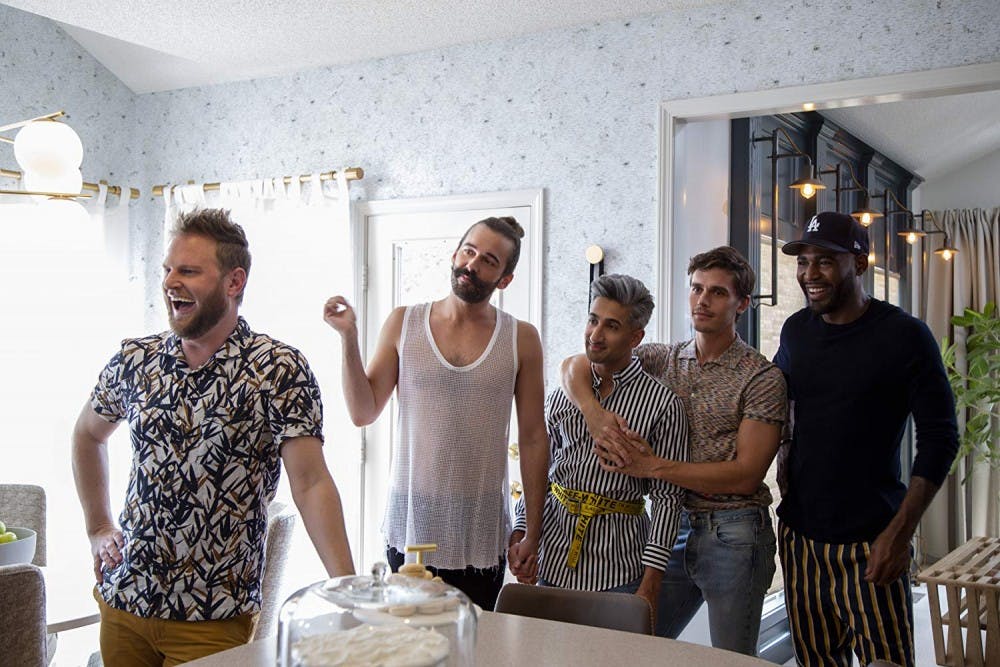With Netflix distributing more and more new series every year, the reality TV genre seems to have seen a reemergence, especially makeover shows. The successes of shows like Tidying Up with Marie Kondo and Amazing Interiors are solid proof of this.
However, no recent makeover show compares to Queer Eye when it comes to sheer popularity. When the original series from the 2000s got the reboot in 2018, it became an instant phenomenon. In the days following the release of the first season, you couldn’t get far online without running into a gif of one of the new Fab Five, especially fan favorite and self care guru Jonathan Van Ness. It wasn’t just him, though; the entire queer quintet of Van Ness (grooming), Antoni Porowski (food and wine), Tan France (fashion), Karamo Brown (culture/lifestyle), and Bobby Berk (interior design) were a charismatic powerhouse, especially as an ensemble. Just like when they hit the scene with the first season, the Fab Five keep things consistently enjoyable with Season 3.
A well-oiled makeover machine

Image from IMDb
Even with Season 1 being incredibly enjoyable, the following season did make small improvements, from more interesting, diverse clients (or “heroes,” as the show calls them) to more eclectic transformations. With Season 3, the formula has been polished even more. As fun as it was during the early episodes to point out things like Antoni’s dedication to avocados and super simple dishes, or Bobby’s habit of making every room blue, those aspects didn’t really make for the most surprising, fresh makeovers. Since then, the Fab Five have consistently shown more versatility when it comes to their transformations.
Tan may be the most predictable when it comes to the transformations, although there are good reasons for this. The standard demographic of the heroes are middle-aged, white, straight, lower middle class men, so the reasonable choices he can make with their fashion are limited. When Tan gets the chance to makeover somebody out of that demographic, the viewer gets to really see what he can do. A prime example from this current season is with Jess, a young black lesbian, on “Black Girl Magic.” He took her self-described “lumberjack lesbian” aesthetic and admiration of black, queer artists like Janelle Monáe and crafted her a wardrobe with some of most fashionable, bold choices the show has ever seen.
The Fab Five are more than just designers

Image from IMDb
Speaking of Jess, her episode, “Black Girl Magic,” is a perfect representation of the best qualities Queer Eye has to offer. While the makeovers are fun to see come to life, it is the connections that the Fab Five make with their heroes that elevate the show. Karamo and Jess relate to one another as two black queer people who didn’t fit into any one niche or stereotype. In one scene where Jess and Bobby are in the car, she tells him about her lack of a family after her adopted family kicked her out after she came out. He is able to connect with her since he went through a similar situation. Unfortunately, this is one of the few moments that Bobby is in the spotlight, but his connection with Jess was one of the highlights of the entire season.
The Gayer, the Better
“Black Girl Magic” is another example that solidifies a pattern among some of the series’ best episodes. All of the episodes that feature LGBTQ heroes present the show at its best. “To Gay or Not To Gay,” the first of this type in the reboot, and “Sky’s the Limit,” which featured the reboot’s first transgender hero in one of the most unconventional episodes Queer Eye has ever seen, are the best episodes of their respective seasons. Even “God Bless Gay,” another one of the show’s best episodes, also has a subplot where the hero’s gay son is learning how to be comfortable with coming back to church.

Image from IMDb
In these episodes, it seems like the Fab Five are more at home, and they connect with their heroes on a deeper level and generally embrace what makes a show like Queer Eye so special. So many of the makeover shows on television seem to be bred for the widest of audiences, resulting in bland, cookie-cutter entertainment. With Queer Eye, and especially this reboot, a new perspective enters the ring, one that is rarely seen on TV, let alone in the makeover television niche. Featuring more stories and perspectives from queer people would only make the show better, more interesting, and a stronger statement than it already is.
Weak start and end leaves the gold in the middle
Much like the past two seasons, there are episodes that drastically pale in comparison to others. When you have episodes as great as “Black Girl Magic” and “Elrod and Sons” being followed by “Sloth to Slay,” the sensation of disappointment is a bit hard to kick. The worst part is that most of the weak episodes are at the bookends of the season; “From Hunter to Huntee” is a soft kick-off when compared to last season’s “God Bless Gay,” and the season finale, “Baby on Board,” lacks the scope of an episode like “Make Ted Great Again” or even “Hose Before Bros.” Queer Eye is a show that does not need to be watched in chronological order, but for those who do so, you’ll have to wait till the middle of the season to reach the highlights.

Featured Image: IMDb
Images: IMDb
For more entertainment related content, visit us at Byte BSU!




















